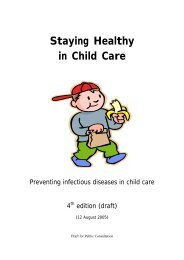Review of Coliforms - National Health and Medical Research Council
Review of Coliforms - National Health and Medical Research Council
Review of Coliforms - National Health and Medical Research Council
Create successful ePaper yourself
Turn your PDF publications into a flip-book with our unique Google optimized e-Paper software.
MICROBIAL INDICATORS OF DRINKING WATER QUALITY<br />
Originally total coliform bacteria were considered to be from four genera <strong>of</strong> the family<br />
Enterobacteriaceae that could all ferment lactose. These genera were Escherichia, Klebsiella,<br />
Enterobacter <strong>and</strong> Citrobacter. Of the total coliforms present in the human gut, Escherichia coli<br />
(E. coli) represents the majority <strong>of</strong> the population (see Box 2). Total coliforms represent only<br />
about 1% <strong>of</strong> the total population <strong>of</strong> bacteria in human faeces in concentrations <strong>of</strong> about 10 9<br />
bacteria per gram (Brenner et al., 1982).<br />
It is widely accepted that the total coliform group <strong>of</strong> bacteria is diverse <strong>and</strong> they can be<br />
considered normal inhabitants <strong>of</strong> many soil <strong>and</strong> water environments which have not been<br />
impacted by faecal pollution. Even though the presence <strong>of</strong> E. coli is considered an appropriate<br />
<strong>and</strong> specific indicator <strong>of</strong> faecal pollution, uncertainty surrounds the use <strong>of</strong> total coliforms as a<br />
health indicator.<br />
As microbiological underst<strong>and</strong>ing about the nature <strong>of</strong> disease <strong>and</strong> the pathogens responsible<br />
increases, techniques have been developed to isolate <strong>and</strong> enumerate pathogenic viruses<br />
<strong>and</strong> protozoa from water. These techniques, however, are not sensible, specific, reliable,<br />
reproducible or inexpensive enough to replace the use <strong>of</strong> bacterial indicators.<br />
2.3 ESCHERICHIA COLI (E. COLI)<br />
More than 100 years ago scientists discovered that human faeces contained bacteria which if<br />
present in water, indicated that the water was not safe to drink. Escherich in 1885 observed<br />
2 types <strong>of</strong> organisms present in faeces, one <strong>of</strong> which he named Bacterium coli (B. coli, which<br />
is now called Escherichia coli) <strong>and</strong> the concept that the presence <strong>of</strong> B. coli implied pollution<br />
<strong>of</strong> water was readily adopted. It is recorded that the concept <strong>of</strong> “indicators” had already been<br />
suggested in 1880 by van Fritsch based on his observations <strong>of</strong> Klebsiellae in human faeces that<br />
were also present in water (Hendricks, 1978).<br />
Initially it was very difficult to distinguish B. coli from other coliform bacteria in water <strong>and</strong><br />
faeces, so methods were developed to recover all coliform bacteria, <strong>and</strong> more detailed <strong>and</strong><br />
lengthy analyses were carried out to confirm if any <strong>of</strong> the recovered coliforms were B. coli.<br />
Water bacteriologists for the next 50 years concentrated on developing these techniques to<br />
confirm the presence <strong>of</strong> B. coli in water <strong>and</strong> tell it apart from other gut bacteria. By the turn<br />
<strong>of</strong> the 20 th century, methods were available that could distinguish B. coli from the bacteria that<br />
caused typhoid (Salmonella typhi), <strong>and</strong> it was known that B. coli produced acid <strong>and</strong> gas from<br />
lactose, whereas Salmonella typhi did not. The techniques founded in the late 1800s <strong>and</strong> early<br />
1900s are still widely used to determine if faecal pollution <strong>of</strong> drinking water has occurred.<br />
5

















